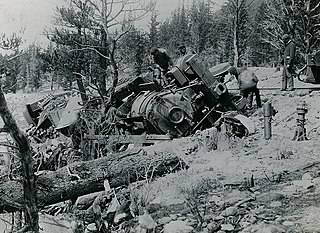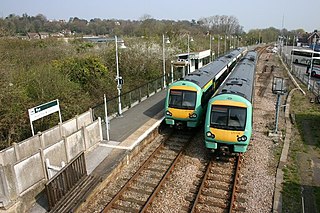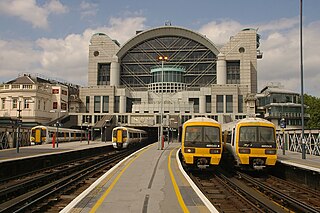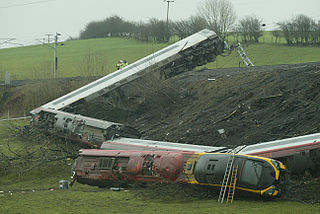
A railroad switch (AE), turnout, or [set of] points (CE) is a mechanical installation enabling railway trains to be guided from one track to another, such as at a railway junction or where a spur or siding branches off.

A railway track or railroad track, also known as a train track or permanent way, is the structure on a railway or railroad consisting of the rails, fasteners, railroad ties and ballast, plus the underlying subgrade. It enables trains to move by providing a dependable surface for their wheels to roll upon. Early tracks were constructed with wooden or cast iron rails, and wooden or stone sleepers; since the 1870s, rails have almost universally been made from steel.

The railway track or permanent way is the elements of railway lines: generally the pairs of rails typically laid on the sleepers or ties embedded in ballast, intended to carry the ordinary trains of a railway. It is described as a permanent way because, in the earlier days of railway construction, contractors often laid a temporary track to transport spoil and materials about the site; when this work was substantially completed, the temporary track was taken up and the permanent way installed.

In rail transport, a derailment is a type of train wreck that occurs when a rail vehicle such as a train comes off its rails. Although many derailments are minor, all result in temporary disruption of the proper operation of the railway system and they are a potentially serious hazard.

The Nuneaton rail crash occurred on 6 June 1975, on the West Coast Main Line just south of Nuneaton railway station in Warwickshire, England, United Kingdom.

The Marshlink line is a railway line in South East England. It runs from Ashford, Kent via Romney Marsh, Rye and the Ore Tunnel to Hastings where it connects to the East Coastway line towards Eastbourne and Brighton.

The Dartford Loop Line is one of three lines linking London with Dartford in Kent, England. It lies to the south of the other two: the North Kent Line and the Bexleyheath Line.

Hither Green is a railway station located in Hither Green in the London Borough of Lewisham, south-east London. It is 7 miles 16 chains (11.6 km) down the line from London Charing Cross and is situated between Lewisham and either Grove Park or Lee depending on the route.

The Ruislip Lido Railway is a 12 in gauge miniature railway around Ruislip Lido in Ruislip, 14 miles (22.5 km) north-west of central London. Running from the main station at Woody Bay by the lido's beach, on a 1.02-mile (1.64 km) track around the reservoir, the railway passes through Ruislip Woods to Willow Lawn station and tea room near the lido's car parks. It is the longest 12 in gauge railway in the United Kingdom.

The South Eastern Main Line is a major long-distance railway route in South East England, UK, one of the three main routes crossing the county of Kent, going via Sevenoaks, Tonbridge, Ashford and Folkestone to Dover. The other routes are the Chatham Main Line which runs along the north Kent coast to Ramsgate or Dover via Chatham and High Speed 1 which runs through the centre of Kent to the coast at Folkestone where it joins the Channel Tunnel.
The Southern Region was a region of British Railways from 1948 until 1992 when railways were re-privatised. The region ceased to be an operating unit in its own right in the 1980s. The region covered south London, southern England and the south coast, including the busy commuter belt areas of Kent, Sussex and Surrey. The region was largely based upon the former Southern Railway area.
The Eltham Well Hall rail crash was an accident on the British railway system that occurred on 11 June 1972 at approximately 21:35. An excursion train from Margate to Kentish Town derailed on a sharp curve at Eltham Well Hall station, Eltham, London. The curve had a maximum permitted speed to be taken at 20 miles per hour (32 km/h) but the train was estimated to have been travelling at 65 miles per hour (105 km/h) resulting in the locomotive and all but one of the ten carriages derailing.

The Thirsk rail crash occurred on 31 July 1967 at Thirsk, Yorkshire, England on the British Rail East Coast Main Line.

The Grayrigg derailment was a fatal railway accident that occurred at approximately 20:15 GMT on 23 February 2007, just to the south of Grayrigg, Cumbria, in the North West England region of the United Kingdom. The accident investigation concluded that the derailment was caused by a faulty set of points on the Down Main running line, controlled from Lambrigg ground frame. The scheduled inspection on 18 February 2007 had not taken place and the faults had gone undetected.
The Eastbourne rail crash was an accident on the British railway system which occurred on 25 August 1958 at Eastbourne railway station in East Sussex. The accident killed five people and injured 41 others. Eastbourne station is a terminus station with services to Hastings, Brighton, London Victoria. At the time of the accident, there was a further service to Tonbridge via the Cuckoo Line. It was then common for services from Hastings to Brighton to enter Eastbourne and reverse to carry on its journey. Trains between Hastings and Brighton have resumed to do this, while services between London Victoria and Ore still do this today, with some calling at Hampden Park twice and an hourly service to Ashford International starting from Eastbourne.
The Rometta Marea derailment occurred on Saturday 20 July 2002 in Rometta Marea, part of the Rometta comune in Sicily, Italy.
Etihad Rail DB was a heavy-rail Operations & Maintenance (O&M) service provider in the UAE. The company was set up in 2013 as a joint venture between Etihad Rail (51%), the developer of the UAE's national railway network and Deutsche Bahn (DB) (49%), Europe's largest railway operator and infrastructure owner. Etihad Rail DB was responsible for the operations and maintenance of Stage One of the UAE's national railway network for Etihad Rail’s primary customer, the Abu Dhabi National Oil Company (ADNOC). Etihad Rail DB concluded an Operations & Maintenance (O&M) Agreement with Etihad Rail in August 2013.

Class 201, Class 202 and Class 203 were the TOPS codes for a series of Diesel-electric multiple units built for the Southern Region of British Railways in 1957–86. They were classified by the Southern Region as 6S, 6L and 6B respectively, and known collectively as the Hastings Diesels or Hastings Units. They were built for service on the Hastings Line, which had a restricted loading gauge due to deficiencies in the construction of the tunnels when the line was built between 1845 and 1852. The Hastings Units served from 1957 to 1988, being withdrawn when the Hastings Line was electrified with single-track sections through some of the tunnels.
On 25 January 2018, a commuter train operated by Trenord derailed in Pioltello when two of its carriages came off the track en route to Milan. The incident left three women dead and more than 100 people injured, of whom 46 needed medical assistance in hospital. Five of them were in critical condition.












